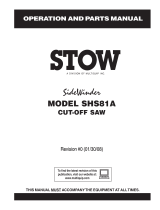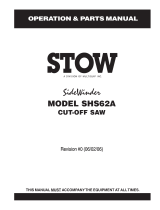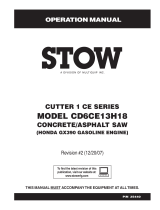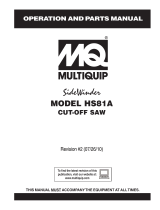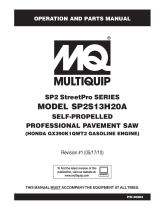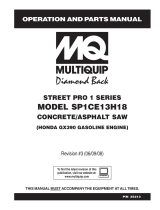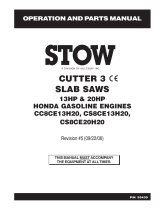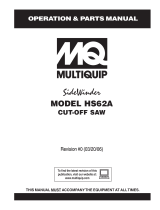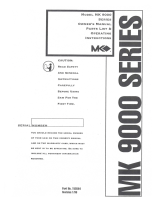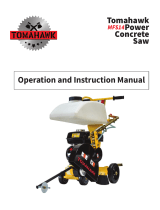Page is loading ...

OPERATION AND PARTS MANUAL
P/N 25498
THIS MANUAL MUST ACCOMPANY THE EQUIPMENT AT ALL TIMES.
To find the latest revision of this
publication, visit our website at:
www.stowmfg.com
CUTTER 1
MODEL CD613H18
Revision #6 (06/06/08)
(HONDA GX390 GASOLINE ENGINE)
MODEL CD605E16
(5 HP ELECTRIC MOTOR)
CONCRETE/ASPHALT SAW

PAGE 2 — STOW CUTTER 1 SAW — OPERATION & PARTS MANUAL — REV. #6 (06/06/08)
Engine exhaust and some of
its constituents, and some dust created
of California to cause cancer, birth
defects and other reproductive harm.
by power sanding, sawing, grinding,
drillingandotherconstructionactivities
contains chemicals known to the State
Some examples of these chemicals are:
Leadfromlead-basedpaints.
Crystallinesilicafrombricks.
Cementandothermasonryproducts.
Arsenicandchromiumfromchemically
treatedlumber.
Your risk from these exposures varies,
dependingonhowoftenyoudothistype
of work. To reduce your exposure to
these chemicals: work in aALWAYS
well ventilated area, and work with
approved safety equipment, such as
dust masks that are specially designed
to filter out microscopic particles.
STOW CUTTER 1 SAW — PROPOSITION 65 WARNING

STOW CUTTER 1 SAW — OPERATION & PARTS MANUAL — REV. #6 (06/06/08) — PAGE 3
NOTES

PAGE 4 — STOW CUTTER 1 SAW — OPERATION & PARTS MANUAL — REV. #6 (06/06/08)
STOW CUTTER 1 SAW — TABLE OF CONTENTS
Proposition 65 Warning ............................................. 2
Table Of Contents ..................................................... 4
Parts Ordering Procedures ....................................... 5
Safety Message Alert Symbols .............................. 6-7
Rules For Safe Operation .................................... 8-10
Specifications (Saw) ................................................ 11
Specifications (Engine) ........................................... 12
STOW — CUTTER 1 SAW
Controls & Components .......................................... 13
Basic Engine ........................................................... 14
Preparation/Pre-Inspection ................................ 15-17
Blades ..................................................................... 18
Blade Placement ..................................................... 19
Initial Start-Up .................................................... 20-21
Operation ................................................................ 21
Maintenance ...................................................... 22-23
Troubleshooting (Saw) ............................................ 24
Troubleshooting (Engine) ................................... 25-26
Explanation of Codes in Remarks Column ............. 28
Suggested Spare Parts ........................................... 29
Nameplate and Decals....................................... 30-31
Engine, Belts And Pulleys Assembly .................. 32-33
Electric Motor Assembly..................................... 34-35
Undercarriage Assembly ................................... 36-37
Blade Assembly & Water System Assembly....... 38-39
Pointer Assembly ............................................... 40-41
NOTE
Specifications and
part numbers are
subject to change
without notice.
HONDA GX390K1QWT2/
GX390U1QWT2 ENGINES
Air Cleaner Assembly......................................... 42-43
Camshaft Assembly ........................................... 44-45
Carburetor Assembly ......................................... 46-47
Control Assembly ............................................... 48-49
Crankcase Cover Assembly ............................... 50-51
Crankshaft Assembly ......................................... 52-53
Cylinder Barrel Assembly ................................... 54-55
Cylinder Head Assembly .................................... 56-57
Fan Cover Assembly .......................................... 58-59
Flywheel Assembly ............................................ 60-61
Fuel Tank Assembly ........................................... 62-63
Ignition Coil Assembly ........................................ 64-65
Muffler Assembly ............................................... 66-67
Piston Assembly ................................................. 68-69
Recoil Starter Assembly..................................... 70-71
Labels ................................................................72-73
Terms and Conditions of Sale — Parts ................... 74

STOW CUTTER 1 SAW — OPERATION & PARTS MANUAL — REV. #6 (06/06/08) — PAGE 5
STOW CUTTER 1 SAW — PARTS ORDERING PROCEDURES
When ordering parts,
please supply the following information:
❒❒
❒❒
❒ Dealer account number
❒❒
❒❒
❒ Dealer name and address
❒❒
❒❒
❒ Shipping address (if different than billing address)
❒❒
❒❒
❒ Return fax number
❒❒
❒❒
❒ Applicable model number
❒❒
❒❒
❒ Quantity, part number and description of each part
❒❒
❒❒
❒ Specify preferred method of shipment:
✓ FedEx or UPS Ground
✓ FedEx or UPS Second Day or Third Day
✓ FedEx or UPS Next Day
✓ Federal Express Priority One
✓ DHL
✓ Truck
Note: Unless otherwise indicated by customer, all
orders are treated as “Standard Orders”, and will
ship within 24 hours. We will make every effort to
ship “Air Shipments” the same day that the order
is received, if prior to 2PM west coast time. “Stock
Orders” must be so noted on fax or web forms.
STOW CONSTRUCTION EQUIPMENTSTOW CONSTRUCTION EQUIPMENT
STOW CONSTRUCTION EQUIPMENTSTOW CONSTRUCTION EQUIPMENT
STOW CONSTRUCTION EQUIPMENT
A DIVISION OF MULTIQUIP INC.
POST OFFICE BOX 6254 CARSON, CA 90749
888-252-STOW [888-252-7869] 310-537-3700
FAX: 310-537-1986 FAX: 800-556-1986
E-MAIL: stow@multiquip.com INTERNET: www.stowmfg.com
Here’s how to get help...
Please have the model and serial number
on hand when calling.
STOW MAIN OFFICE
18910 Wilmington Ave. 800-421-1244
Carson, CA 90746
FAX:
310-537-3927
Email: stow@stowmfg.com
Internet: www.stowmfg.com
SALES DEPARTMENT
310-661-4242 Fax: 310-604-9237
877-289-7869 (877-BUY-STOW)
PARTS DEPARTMENT
800-427-1244
FAX:
800-672-7877
310-537-3700
FAX:
310-637-3284
SERVICE DEPARTMENT
800-478-1244
FAX:
310-537-4259
310-537-3700
TECHNICAL ASSISTANCE
800-478-1244
FAX:
310-631-5032
WARRANTY DEPARTMENT
800-421-1244,
EXT.
279
FAX:
310-537-1173
310-537-3700,
EXT.
279
Extra Discounts!
All parts orders which include complete part numbers and
are received by our automated web parts order system, or
by fax qualify for the following extra discounts:
Ordered Standard Stock orders
via orders ($750 list and above)
Fax 3% 10%
Web 5% 10%
Special freight allowances
when you order 10 or more
line items via Web or Fax!**
FedEx Ground Service
at no charge for freight
No other allowances on freight shipped by any other
carrier.
**Common nuts, bolts and washers (all items under $1.00
list price) do not count towards the 10+ line items.
Place Your Parts Order Via Web or Fax
For Even More Savings!
(Domestic USA Dealers Only)
NOTE: DISCOUNTS ARE SUBJECT TO CHANGE
Direct TOLL-FREE access
to our Parts Department:
Toll-free nationwide — 800-427-1244
Toll-free FAX — 800-6-PARTS-7
(800/672-7877)

PAGE 6 — STOW CUTTER 1 SAW — OPERATION & PARTS MANUAL — REV. #6 (06/06/08)
STOW CUTTER 1 SAW — SAFETY MESSAGE ALERT SYMBOLS
Safety precautions should be followed at all times when operating
this equipment. Failure to read and understand the Safety
Messages and Operating Instructions could result in injury to
yourself and others.
FOR YOUR SAFETY AND THE SAFETY OF OTHERS!
This Owner's Manual has been developed to provide
complete instructions for the safe and efficient operation
of the
STOW CUTTER 1 SAW
. For engine maintenance
information, please refer to the engine manufacturers
instructions for data relative to its safe operation.
Before using this CONCRETE/ASPHALT SAW,
ensure that the operating individual has read and
understands all instructions in this manual.
NOTE
SAFETY MESSAGE ALERT SYMBOLS
The three (3) Safety Messages shown below will inform you
about potential hazards that could injure you or others. The
Safety Messages specifically address the level of exposure to
the operator, and are preceded by one of three words: DANGER,
WARNING, or CAUTION.
DANGER: You WILL be KILLED or
SERIOUSLY injured if you DO NOT follow
directions.
WARNING: You CAN be KILLED or
SERIOUSLY injured if you DO NOT follow
directions.
CAUTION: You CAN be injured if you
DO NOT follow directions.
HAZARD SYMBOLS
Engine exhaust gases contain poisonous
carbon monoxide. This gas is colorless and
odorless, and can cause death if inhaled.
NEVER operate this equipment in a confined
area or enclosed structure that does not
provide ample free flow air.
Potential hazards associated with STOW CUTTER 1 SAW
operation will be referenced with "
Hazard Symbols
" which
appear throughout this manual, and will be referenced in
conjunction with Safety "
Message Alert Symbols
".
Gasoline is extremely flammable, and its
vapors can cause an explosion if ignited. DO
NOT start the engine near spilled fuel or
combustible fluids. DO NOT fill the fuel tank
while the engine is running or hot. DO NOT
overfill tank, since spilled fuel could ignite if it
comes into contact with hot engine parts or
sparks from the ignition system. Store fuel in
approved containers, in well-ventilated areas
and away from sparks and flames. NEVER
use fuel as a cleaning agent.
Burn Hazards
Engine components can generate extreme heat.
To prevent burns, DO NOT touch these areas
while the engine is running or immediately after
operations. NEVER operate the engine with
heat shields or heat guards removed.
Rotating Parts
NEVER operate equipment with covers, or
guards removed. Keep
fingers
,
hands
,
hair
and
clothing
away from all moving parts to
prevent injury.
Explosive Fuel
Lethal Exhaust Gases

STOW CUTTER 1 SAW — OPERATION & PARTS MANUAL — REV. #6 (06/06/08) — PAGE 7
Accidental Starting
ALWAYS place the engine ON/OFF
switch in the OFF position, when the saw
is not in use.
Over Speed Conditions
NEVER tamper with the factory settings of the
engine governor or settings. Personal injury
and damage to the engine or equipment can
result if operating in speed ranges above
maximum allowable.
Respiratory Hazard
ALWAYS wear approved respiratory protection.
ALWAYS wear approved eye and hearing
protection.
Sight and Hearing hazard
Equipment Damage Messages
Other important messages are provided throughout this manual
to help prevent damage to your concrete saw, other property, or
the surrounding environment.
STOW CUTTER 1 SAW — SAFETY MESSAGE ALERT SYMBOLS
Guards and Covers In Place
NEVER operate the saw without blade guards
and covers in place. Adhere to safety
guidelines ANSI, OSHA, or other applicable
local regulations.
This
concrete/asphalt saw
, other
property, or the surrounding
environment could be damaged if
you do not follow instructions.
Rotating Blade
Rotating blade can cut and crush. Keep
hands and feet clear.
NOTE

PAGE 8 — STOW CUTTER 1 SAW — OPERATION & PARTS MANUAL — REV. #6 (06/06/08)
CAUTION:
Failure to follow instructions in this manual may
lead to serious injury or even death! This
equipment is to be operated by trained and
qualified personnel only! This equipment is
for industrial use only.
The following safety guidelines should always be used when
operating the STOW CUTTER 1 SAW . Unless otherwise noted,
these guidelines refer to saws with gasoline powered engines.
SAFETY
■
DO NOT operate or service this equipment
before reading this entire manual.
■
This equipment should not be operated by persons under 18
years of age.
■
NEVER operate the saw without proper protective
clothing, shatterproof glasses, steel-toed boots
and other protective devices required by the job.
■
NEVER operate this equipment when not
feeling well due to fatigue, illness or taking
medicine.
■
NEVER operate the saw under the
influence or drugs or alcohol.
■
NEVER use accessories or attachments, which are not
recommended by STOW or Multiquip for this equipment.
Damage to the equipment and/or injury to user may result.
■
Manufacturer does not assume responsibility for any accident
due to equipment modifications. Unauthorized equipment
modification will void all warranties.
■
Whenever necessary, replace nameplate, operation and
safety decals when they become difficult read.
■
ALWAYS check the saw for loosened hardware such as nuts
and bolts before starting.
■
ALWAYS use extreme caution when
working with flammable liquids. When
refueling, STOP the engine and allow
it to cool.
■
NEVER
smoke
around or near the
machine. Fire or explosion could result from
fuel vapors
, or if fuel is spilled on a
hot!
engine.
■
NEVER operate the saw in an explosive atmosphere where
fumes are present or near combustible materials. An explosion
or fire could result causing severe
bodily harm or even
death.
■
Topping-off to filler port is dangerous, as it tends to spill fuel.
■
NEVER use fuel as a cleaning agent.
■
NEVER touch the hot exhaust
manifold, muffler or cylinder. Allow
these parts to cool before servicing
the saw.
■
The engine of this saw requires an adequate free flow of
cooling air. NEVER operate the saw in any enclosed or narrow
area where free flow of the
air is restricted. If the air flow
is restricted it will cause
serious damage to the saw's
engine and may cause injury
to people. Remember the
saw's engine gives off
DEADLY
carbon monoxide
gas.
■
High Temperatures – Allow the engine to cool before adding
fuel or performing service and maintenance functions. Contact
with
hot!
components can cause serious burns.
■
ALWAYS refuel in a well-ventilated area, away from sparks
and open flames.
STOW CUTTER 1 SAW — RULES FOR SAFE OPERATION
RULES FOR SAFE OPERATION

STOW CUTTER 1 SAW — OPERATION & PARTS MANUAL — REV. #6 (06/06/08) — PAGE 9
STOW CUTTER 1 SAW — RULES FOR SAFE OPERATION
Diamond Blade Safety
■
Use appropriate steel centered diamond blades
manufactured for use on concrete saws.
■
ALWAYS inspect diamond blades
before each use. The blade should
exhibit no cracks, dings, or flaws in
the steel centered core and/or rim.
Center (arbor) hole must be
undamaged and true.
■
Examine blade flanges for damage, excessive wear and
cleanliness before mounting blade. Blade should fit snugly
on the shaft and against the inside/outside blade flanges.
■
Ensure the blade is marked with an operating speed greater
than the blade shaft speed of the saw.
■
Only cut the material that is specified by the diamond blade.
Read the specifications of the diamond blade to ensure the
proper tool has been matched to the material being cut.
■
ALWAYS keep blade guards in place. Exposure of the
diamond blade must not exceed 180 degrees.
■
Ensure that the diamond blade does not come into contact
with the ground or surface during transportation. DO NOT
drop the diamond blade on ground or surface.
■
The engine governor is designed to permit maximum engine
speed in a no-load condition. Speeds that exceed this limit
may cause the diamond blade to exceed the maximum safe
allowable speed.
■
Ensure that the blade is mounted for proper operating
direction.
General Safety
■
ALWAYS read, understand, and follow procedures in
Operator's Manual before attempting to operate equipment.
■
ALWAYS be sure the operator is familiar with proper safety
precautions and operating techniques before using the saw.
■
NEVER leave the machine
unattended
while running.
■
Block the unit when leaving or when using on a slope.
■
ALWAYS check to make sure that the operating area is clear
before starting the engine.
■
Maintain this equipment in a safe operating condition at all
times.
■
ALWAYS stop the engine before servicing, adding fuel and
oil.
■
NEVER run the engine without the air filter. Severe engine
damage could occur.
■
ALWAYS service air cleaner frequently to prevent carburetor
malfunction.
■
AVOID wearing jewelry or loose fitting clothing that may snag
on the controls or moving parts, this can cause a serious
injury.
■
ALWAYS keep clear of
rotating
or
moving parts
while the
saw is in operation.
■
ALWAYS store equipment properly when it is not being used.
Equipment should be stored in a clean, dry location out of
the reach of children.
■
NEVER use accessories or attachments which are not
recommended by the manufacturer for this equipment.
Damage to the equipment and/or injury to user may result.
WARNING
■
ALWAYS check to make sure that the
operating area is clear before starting the
engine.
■
Keep all inexperienced and unauthorized people away from
the equipment at all times.
WARNING
Electric Saws
■
ALWAYS connect electric motor of the saw to a power source
in compliance with all local and state electrical codes. This
must be performed by a qualified electrician. After this
connection is made, it will be necessary to check the rotation
of the motor shaft. The shaft rotation should be
counter-
clockwise
when viewing the motor from the shaft extension
end. If the rotation of the shaft is incorrect make necessary
changes for the correct shaft rotation.
■
MAKE CERTAIN the power cord/extension cord is free from
damage and that the grounding circuit is operational.
■
MAKE CERTAIN the extension cord that you are using is
intended to be used in the environment you are using it in. If
an extension is used, NEVER submerge the connection in
water. To reduce the risk of electric shock, always make water-
tight connections.
■
MAKE CERTAIN the "ON/OFF" switch is in the "OFF" position
before plugging in the power cord/extension cord to avoid
accidental starting.
■
Use only the gauge wire and length of cord recommended for
the motor size. Refer to Table 3 in this manual.
■
When cutting, ALWAYS be aware of the location of the cord.
■
NEVER use a
worn
,
frayed
or
damaged
extension cord.

PAGE 10 — STOW CUTTER 1 SAW — OPERATION & PARTS MANUAL — REV. #6 (06/06/08)
Figure 1. STOW CUTTER 1 SAW Decals
STOW CUTTER 1 SAW — RULES FOR SAFE OPERATION
EMERGENCIES
■
ALWAYS know the location of
the nearest
fire extinguisher
.
■
ALWAYS know the location of the
nearest
first aid kit
.
■
In emergencies
always
know the location of the
nearest phone or
keep a phone on the job site
.
Also know the phone numbers of the nearest
ambulance
,
doctor,
and
fire department
. This
information will be invaluable in the case of an
emergency.
Saw Transportation Safety
■
Use appropriate lifting equipment to ensure the safe
movement of the saw.
■
DO NOT use the handle bars and/or front pointer as lifting
points.
■
When trasporting of the saw is required, place saw directly
inside towing vehicle truck-bed and tie-down securely.
NEVER tow saw directly behind towing vehicle.
■
DO NOT use the saw on slopes or on extremely un-level
surfaces. An engine tipped to extreme angles may cause oil
to gravitate into the cylinder head making the engine start
difficult.
■
NEVER transport the saw with the blade
mounted.
Machine Operation And Safety Decals
The STOW CUTTER 1 SAW is equipped with a number of
operation and safety decals. Should any of these decals become
unreadable, replacements can be obtained from your dealer.

STOW CUTTER 1 SAW — OPERATION & PARTS MANUAL — REV. #6 (06/06/08) — PAGE 11
STOW CUTTER 1 SAW — SPECIFICATIONS (SAW)
Figure 2. STOW CUTTER 1 SAW Dimensions
Side View
Front View
A
C
B
F
G
D
E
snoitacificepS1rettuC.1elbaT
RETTELECNEREFER NOITPIRCSED )mc(NOISNEMID
A
thgieHxaM
)mc49(.nI0.73
B
)desiaRretnioPtnorF(htgneLxaM
)mc08(.nI0.23
C
)derewoLretnioPtnorF(htgneLxaM
)mc831(.nI5.45
D
htdiWxaM )mc55(.nI5.12
E
esaBleehWraeR )mc04(.nI0.71
F
esaBleehWtnorF )mc4.52(.nI0.01
G
htdiWraBeldnaH )mc55(.nI5.12
ENIGNE
EPYT
NOITPIRCSED )GK(THGIEW
ENIGNEADNOHPH31,1RETTUC )g.K79(.sbl412

PAGE 12 — STOW CUTTER 1 SAW — OPERATION & PARTS MANUAL — REV. #6 (06/06/08)
STOW CUTTER 1 SAW — SPECIFICATIONS (ENGINE)
)enignE(snoitacificepS.2elbaT
enignE
ledoM
ADNOH
2TWQ1U093XG/2TWQ1K093XG
epyT
elgniS,ekorts4delooc-riA
enignEenilosaG,VHO,rednilyC
ekortSX
eroB
.ni5.2X.ni5.3
)mm46xmm88(
tnemecalpsiD)cc983(.ni-uc7.32
tuptuOxaM.M.P.R0063/.P.H0.31
yticapaCknaTleuF
snollaG.S.U27.1.xorppA
)sretiL5.6(
leuF
enilosaGelibomotuAdedaelnU
rehgihroenatcO68
yticapaCliOebuL)retil1.1(tqSU61.1
lortnoCdeepS
dohteM
epyTthgiew-ylFlagufirtneC
dohteMgnitratStratSlioceR
noisnemiD
)HxWxL(
.ni4.71X7.71x0.51
)mm344X054X083(
yrD
thgieWteN
).gK13(sbl4.86

STOW CUTTER 1 SAW — OPERATION & PARTS MANUAL — REV. #6 (06/06/08) — PAGE 13
STOW CUTTER 1 SAW — CONTROLS & COMPONENTS
Figure 3 shows the location of the basic controls or components
for the STOW CUTTER 1 SAW. Listed below is a brief
explanation of each control or component. (Gasoline-powered
unit shown)
1. Hand Grips/Handlebar – When operating the saw, place
both hands on each grip to maneuver the saw. Replace
hand grips when they become worn or damaged.
2. Handle Lock – Lock blade depth to desired position.
3. Garden Hose Connecter – Connect to water source to
provide blade cooling while cutting concrete or asphalt.
4. Air Filter – Prevents dirt and debris from entering the engine
air intake. Check filter periodically and keep cleaned or
replace when necessary.
5. Recoil Starter Handle – Pull to engage and start the
engine.
6. Recoil Starter Assembly – Engages the engine when
the handle is pulled and rewinds the starter rope when the
handle is released.
7. Wheels/Carriage Assembly – Heavy-duty polyurethane
wheels with permanently sealed ball bearings.
CONTROLS & COMPONENTS
Figure 3. Cutter 1
8. Cutting Blade – Use appropriate type blades for cutting
concrete or asphalt.
9. Blade Guard – Covers saw blade and flips up to allow
blade to be changed.
10. Belt Tension Adjuster – Adjusts belt tension.
11. Front Pointer – Front pointer wheel assists in straight
tracking.
12. Front Pointer Arm – Stows up for storage and pivots down
for use.
13. Cutting Depth Adjuster – turn operating crank clockwise
or counter-clockwise to adjust the cutting depth up or down.
14. Fuel Tank – Use unleaded gasoline. Do not overfill.
15. Blade Coolant System – Provides cooling water to blade
during cutting operations.
16. V-Belt Cover – Remove this cover to gain access to the V-
belt. NEVER operate the saw with this cover removed.
17. Arbor Shaft Grease Zerks – Conveniently located for
lubrication.
18. On/Off Switch – Turn to the "ON" position to allow engine
to be started and turn to the "OFF" position to shut the
engine off.

PAGE 14 — STOW CUTTER 1 SAW — OPERATION & PARTS MANUAL — REV. #6 (06/06/08)
Figure 4. Engine Controls and Components
Initial Servicing
The engine (Figure 4) must be checked for proper lubrication and
filled with fuel prior to operation. Refer to the manufacturers engine
manual for instructions & details of operation and servicing.
1. Fuel Filler Cap – Remove this cap to add unleaded
gasoline to the fuel tank. Make sure cap is tightened
securely. DO NOT over fill.
6. Choke Lever – Used in the starting of a cold engine, or in
cold weather conditions. The choke enriches the fuel
mixture.
7. Air Cleaner – Prevents dirt and other debris from entering
the fuel system. Remove wing-nut on top of air filter
cannister to gain access to filter element.
Operating the engine without an air
filter, with a damaged air filter, or a
filter in need of replacement will
allow dirt to enter the engine, causing
rapid engine wear.
8. Spark Plug – Provides spark to the ignition system. Set
spark plug gap to 0.6 - 0.7 mm (0.028 - 0.031 inch) Clean
spark plug once a month.
9. Muffler – Used to reduce noise and emissions.
Engine components can generate extreme heat.
To prevent burns, DO NOT touch these areas
while the engine is running or immediately after
operating. NEVER operate the engine with the muffler removed.
10. Fuel Tank – Holds unleaded gasoline. For additional
information refer to engine owner's manual.
DANGER
WARNING
STOW CUTTER 1 SAW — BASIC ENGINE
Adding fuel to the tank should be done only when
the engine is stopped and has had an opportunity
to cool down. In the event of a fuel spill, DO NOT attempt to start the
engine until the fuel residue has been completely wiped up, and the
area surrounding the engine is dry.
2. Throttle Lever – Used to adjust engine RPM speed (lever
advanced forward
SLOW
, lever back toward operator
FAST
).
3. Engine ON/OFF Switch – ON position permits engine
starting, OFF position stops engine operations.
4. Recoil Starter (pull rope) – Manual-starting method. Pull
the starter grip until resistance is felt, then pull briskly and
smoothly.
5. Fuel Valve Lever – OPEN to let fuel flow, CLOSE to stop
the flow of fuel.
NOTE
BASIC ENGINE

STOW CUTTER 1 SAW — OPERATION & PARTS MANUAL — REV. #6 (06/06/08) — PAGE 15
STOW CUTTER 1 SAW — PREPARATION/PRE-INSPECTION
PREPARATION / PRE-INSPECTION
1. Read and fully understand this manual,
the safety instructions in particular, and
the engine manufacturer's manual
supplied with the saw.
2. Select the correct blade for each application. If abrasive
blades are used, MAKE CERTAIN they are designed for
use on a concrete floor saw. They must be reinforced and
have a hole for the driving pin. When wet cutting with an
abrasive blade, MAKE CERTAIN the blade is intended for
wet cutting. Water will destroy a dry cut abrasive blade.
Some diamond blades require water cooling and failure to
do so will destroy them almost immediately. Other diamond
blades can be used with or without water. Refer to the Blades
and Blade Placement sections on pages 18 and 19 for further
information.
3. Handle all blades with care and NEVER use a damaged
blade. NEVER use an abrasive blade that has been
dropped.
Electric Powered Saws (50 or 60 HZ)
1. The electric motor of this saw requires 230 VAC input
voltage (50/60 Hz, single-phase). Always make certain that
the rated operating line voltage of the motor is correct when
cutting. Electric motors can burn out when the line voltage
falls 10% below the voltage rating of the motor.
2. After the correct input voltage has been applied to the saw,
turn the saw on, and check the rotation of the motor shaft.
The shaft rotation MUST be counter-clockwise when
viewing the motor from the shaft extension end. If the rotation
of the shaft is incorrect make the necessary changes for
the correct shaft rotation.
3. MAKE CERTAIN the correct size extension cord is used.
Undersize extension cords can burn out an electric motor.
Use Table 3 to determine the correct extension cord size.
4.
NEVER!
use a
worn
or
frayed
extension cord.
5. Record the model and serial number of the saw on the
front of the Operating and Parts Manual for future reference.
WARNING
ALWAYS use a grounded (3-wire) extension cord and MAKE
CERTAIN that the motor is connected to a properly grounded
electric circuit to protect the operator from possible electric shock.
Figure 6. Engine Oil Dipstick (Removal)
Gasoline Powered Saws
1. Clean the
saw,
removing dirt and dust, particularly the
engine cooling air inlet, carburetor and air cleaner.
2. Check the air filter for dirt and dust. If air filter is dirty, replace
air filter with a new one as required.
3. Check carburetor for external dirt and dust. Clean with dry
compressed air.
4. Check fastening nuts and bolts for tightness.
Engine Oil Check
1. To check the engine oil level, place the saw on secure level
ground with the engine stopped. The frame platform
must
be level
to accurately check the engine oil.
2. Remove the filler dipstick from the engine oil filler hole
(Figure 6) and wipe it clean.
eziSdroCnoisnetxE.3elbaT
eriW21.oNeriW01.oNeriW8.oNeriW6.oN
)teef(05
)sretem42.51(
)teef(57
sretem68.22(
)teef(001
sretem84.03(
)teef(00
2
sretem69.06(
NEVER!
touch the power cord (Figure 5) with
wet hands
or while
standing in water
when it is connected to a power source. The
possibly exists of electrical shock (electrocution)
even death.
NEVER!
spray water directly on
the electric motor.
POWER
CORD
(POWER ON)
WET
HANDS
Figure 5. Extension Cord (Wet Hands)

PAGE 16 — STOW CUTTER 1 SAW — OPERATION & PARTS MANUAL — REV. #6 (06/06/08)
Figure 6. Engine Oil Dipstick (Oil Level)
Fuel Check
Motor fuels are highly flammable and can be
dangerous if mishandled. DO NOT smoke
while refueling. DO NOT attempt to refuel the
trowel if the engine is
hot!
or
running
.
Explosive Fuel
1. Remove the gasoline cap located on top of fuel tank.
2. Visually inspect to see if fuel level is low. If fuel is low, replenish
with unleaded fuel.
3. When refueling, be sure to use a strainer for filtration. DO
NOT top-off fuel. Wipe up any spilled fuel.
NOTE
Reference manufacturer engine
manual for specific servicing
instructions.
epyTliO.4elbaT
nosaeS erutarepmeT epyTliO
remmuS rehgiHroC°52 03-W01EAS
llaF/gnirpS C°01~C°52 02/03-W01EAS
retniW rewoLroC°0 01-W01EAS
NEVER operate the saw without blade guards
and covers in place. DO NOT operate with
the front of the blade guard raised. The blade
exposure cannot exceed 180 degrees during
operation. Adhere to the safety guidelines of
the American National Standards Institute
(ANSI) B7.1 and B7.5.
WARNING
Figure 7. Blade Guard
CHECK the following on the blade guard (Figure 8):
■
Ensure the capacity of the blade guard matches the diameter
of your diamond blade.
■
Check that the guard is bolted firmly upon the saw frame.
■
Check that the spring tensioned front cover of the guard is
firmly seated with the rear section of the guard and there are
no gaps. NEVER lift the blade guard while cutting.
CAUTIONCAUTION
CAUTIONCAUTION
CAUTION
NEVER attempt to check
the V-belt with the engine
running. Severe injury can
occur. Keep fingers, hands,
hair, and clothing away
from all moving parts.
V-Belt Check
A worn or damaged V-belt can adversely affect the performance
of the saw. If a V-belt is defective or worn, replace ALL the V-
belts. V-belts should always be replaced in sets.
Guards And Covers
ENSURE the V-belt Cover is in place and securely fastened
during operation of the saw (Figure 8).
STOW CUTTER 1 SAW — PREPARATION/PRE-INSPECTION
3. Insert and remove the dipstick without screwing it into the filler
neck. Check the oil level shown on the dipstick.
4. If the oil level is low (Figure 7), fill to the edge of the oil filler
hole with the recommended oil type (Table 4).

STOW CUTTER 1 SAW — OPERATION & PARTS MANUAL — REV. #6 (06/06/08) — PAGE 17
Figure 10. Pulley Alignment
3. Check V-belt tension by using a tension meter (3.0 lbs.)
against the inside belt at a mid point between the two pulleys,
or by deflecting the center belt at a mid point 3/16" (5 mm).
4. DO NOT over or under tighten the V-belt. Severe damage
can occur to the saw and engine crankshaft if the belt is
over-tensioned. A decrease of power to the blade and poor
performance will result if the belt is under-tensioned (loose
on pulleys).
STOW CUTTER 1 SAW — PREPARATION/PRE-INSPECTION
Figure 9. V-Belt Cover
V-belt Alignment and Tensioning
This saw is equipped with a premium V-belt that has been aligned
and tensioned by factory personnel. The V-belt must be aligned
and tensioned for proper operation of the saw.
Use the following procedure to check the alignment of V-belt:
1. Remove the bolts that secure the V-belt cover (Figure 9) to
the saw frame.
2. Check uniform parallelism (Figure 10) of V-belt and pulley
(sheaves). Use a straight-edge or machinist's square against
both pulleys and adjust both pulleys until equally aligned.
NOTE
V-belt alignment must be
rechecked after adjusting belt
tension.

PAGE 18 — STOW CUTTER 1 SAW — OPERATION & PARTS MANUAL — REV. #6 (06/06/08)
WARNING
Failure to thoroughly inspect the diamond
blade (Figure 11) for operational safety
could result in damage to the blades or
the saw and may cause injury to the user
or others in the operating area.
Figure 11. Diamond Blade
BLADES
Saw blades, or cutting disks, are available in either an abrasive
design or as diamond blades. Either blade will work on the
STOW CUTTER 1 SAW , however, diamond blades are
recommended. Ask your dealer about your specific cutting
application.
SAW BLADE INSPECTION
1. Stress Relief Holes (Gullets) - Check the steel core for
cracks that may have propagated from the slots and/or
gullets. Cracks indicate extreme fatigue failure and if sawing
continues, catastrophic failure will occur.
STOW CUTTER 1 SAW — BLADES
2. Edge of the Steel Core - Check the diameter edge for
discoloration (blue oxidation) indicating an overheating
condition caused by insufficient cooling water/air.
Overheating of blades may lead to loss of core tension and/
or increase the possibility for blade failure. Make sure the
steel core's width is uniform about the rim of the blade, and
not succumbing to an "under-cutting" condition brought
about by highly abrasive material or improper under-cutting
core protection.
3. Directional Arrow - Ensure that the blade is oriented
properly on the blade shaft for sawing. Reference the
directional arrow on the blade and place it so the direction
of rotation "downcuts" with the turn of the shaft.
4. Diamond Segment or Rim - Ensure there are no cracks,
dings, or missing portions of the diamond segment/rim. DO
NOT
use a blade that is missing a segment or a portion
of the rim.
Damaged and /or missing segments/rims may
cause damage to your saw or injury to the user or others in
the operating area.
5. Specifications - Ensure that the blade specifications, size,
and diameter properly match up to sawing operations.
Utilizing a blade not matched properly to the task may result
in poor performance and/or blade damage.
6. Arbor Hole - It is essential that the arbor hole diameter
properly matches the blade, and that it is free from distortion.
Correct blade flanges (collars) must be used. The inside
face of the flanges must be clean and free of debris. An out-
of-round arbor condition will cause damage to the blade
and the saw.
7. MAX RPM - This RPM reference is the maximum safe
operating speed for the blade selected. NEVER exceed the
max RPM on the diamond blade. Exceeding the maximum
RPM is dangerous and may cause poor performance and
may damage the blade.

STOW CUTTER 1 SAW — OPERATION & PARTS MANUAL — REV. #6 (06/06/08) — PAGE 19
Cutting Depth Adjustment
The saw is equipped with a Raise/Lower Assembly that is
supported by the following components.
■
Raise/Lower Acme Screw
■
Jack Arm
■
Blade Guard
■
Adjusting Handle Crank
STOW CUTTER 1 SAW — BLADE PLACEMENT
WARNING
Failure to thoroughly inspect the diamond
blade for operational safety could result in
damage to the blades or the saw and may
cause injury to the user or others in the
operating area.
1. Blade Guard - Pivot the blade guard
front cover all the way back. The guard
tension spring will keep the front cover in position.
2. Blade Hex Nut - Unscrew the blade shaft nut (right side
loosens clockwise and tightens counter-clockwise while the
left side loosens counter-clockwise and tightens clockwise.
DO NOT overtighten the nut (approximately 45-50 ft. lb/61-
68 N/m) when finalizing the assembly.
3. Outside Blade Flange (Collar) - Ensure that the outside
blade flange is placed flush against the diamond blade.
The inside surface of the flange must be free of debris and
permit a tight closure on the surface of the blade core.
5. Inner Flange (Collar) - This flange is fixed upon the blade
shaft. The inside surface of the flange must be free of debris
and permit a tight closure on the surface of the blade.
The following steps should be
accomplished before using the saw
on any cutting surface.
NOTE
4. Diamond Blade - Ensure that the proper diamond blade
has been selected for the job. Pay close attention to the
directional arrows on the blade. The blade's operating
directional arrows must point in a "down-cutting" direction
to perform correctly. When placing the blade onto the blade
shaft, ensure the arbor hole of the blade matches the
diameter of the shaft.
WARNING
Dropping or forcing the
blade onto the cutting
surface can severely
damage the diamond blade and may
cause serious damage to the saw and
bodily harm.
Blade Removal and Replacement
1. Set the engine ON/OFF switch to the
"OFF" position. (Unplug electric
models.)
2. Place the saw on a stable level working
surface.
3. Ensure the blade is raised and the raise/lower crank is locked
into position.
When removing or installing a
diamond blade, please note that the
blade retaining nuts are left and right-
hand threaded.
NOTE
BLADE PLACEMENT
5. Lift up the blade guard cover to gain access to the blade.
6. Use the provided blade nut and blade shaft locking
wrenches to remove and install the blade.
■
While holding the blade shaft with the locking wrench,
remove the blade hex nut (clockwise direction) and outer
blade flange.
■
Remove the old blade and install a new blade in the
same rotational direction as marked on the old blade.
■
Reinstall the outer blade flange and hex nut. Tighten
the nut firmly (counter-clockwise direction). DO NOT
OVER TIGHTEN.
Blade Speed
A diamond blade’s performance is directly connected to specific
peripheral (rim) speeds.
The following shaft rotational speeds have been factory set to
ensure optimum blade performance.
z
CUTTER 1- 18-inch (457.2 mm) Capacity - 2,836 RPM.

PAGE 20 — STOW CUTTER 1 SAW — OPERATION & PARTS MANUAL — REV. #6 (06/06/08)
4. Place the
Choke Lever
(Figure 14) in the "
CLOSED
"
position.
STOW CUTTER 1 SAW — INITIAL START-UP
DO NOT attempt to operate the saw until
the Safety, General Information and
Inspection sections of this manual have
been read and thoroughly understood.
Depending on engine manufacturer,
operating steps may vary. See engine
manufactures operating manual.
Figure 12. Engine Fuel Valve Lever
Figure 13. Engine ON/OFF Switch
CAUTIONCAUTION
CAUTIONCAUTION
CAUTION
CAUTIONCAUTION
CAUTIONCAUTION
CAUTION
1. Ensure the diamond blade has been mounted correctly and
that it is raised above the surface you are about to saw.
2. Place the
fuel valve lever
(Figure 12) to the "ON" position.
3. Place the
Engine ON/OFF switch
(Figure 13) in the "ON"
position.
The CLOSED position of the
choke lever enriches the fuel
mixture for starting a COLD engine.
The OPEN position provides the
correct fuel mixture for normal
operation after starting, and for
restarting a warm engine.
The engine speed has
been set at the factory.
Changing the governor
speed could damage the
blade and/or the saw.
Figure 14. Choke Lever
NOTE
CAUTIONCAUTION
CAUTIONCAUTION
CAUTION
NEVER operate the saw in
a confined area or
enclosed area structure
that does not provide ample
free flow of air
.
ALWAYS wear approved eye and hearing
protection before operating the saw.
NEVER place hands or feet inside the belt
guard or blade guard while the engine is
running. ALWAYS shut the engine down
before performing any kind of maintenance
service on the saw.
INITIAL START-UP
/
